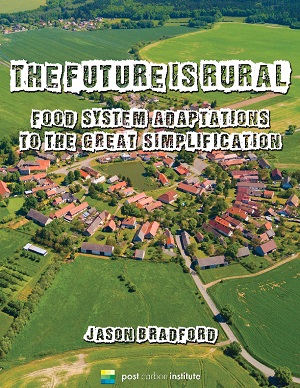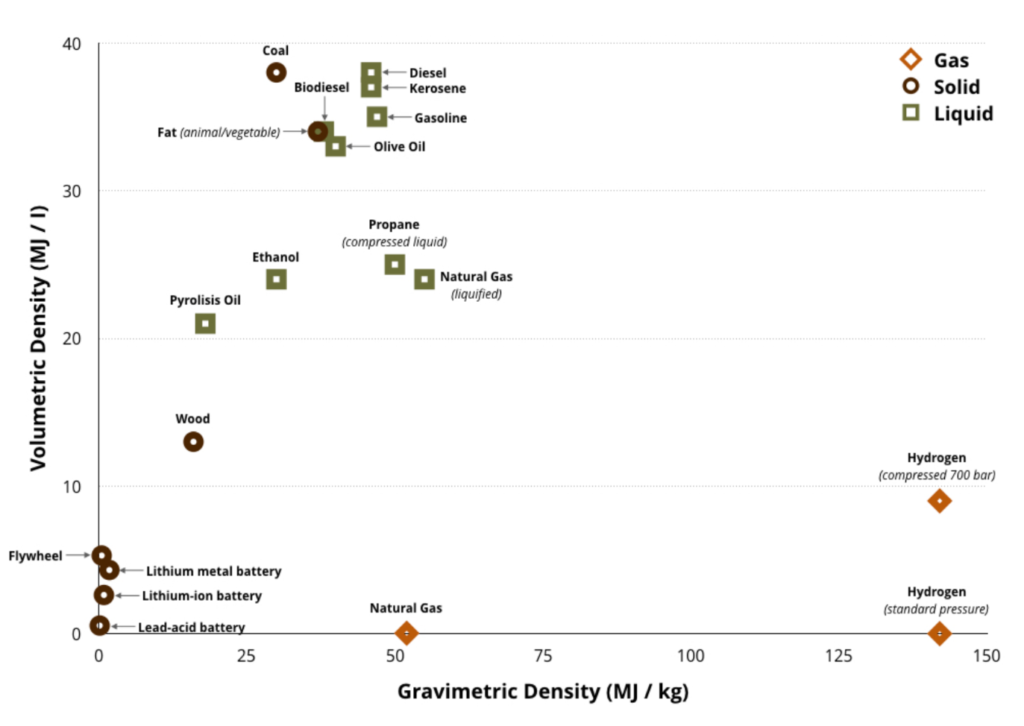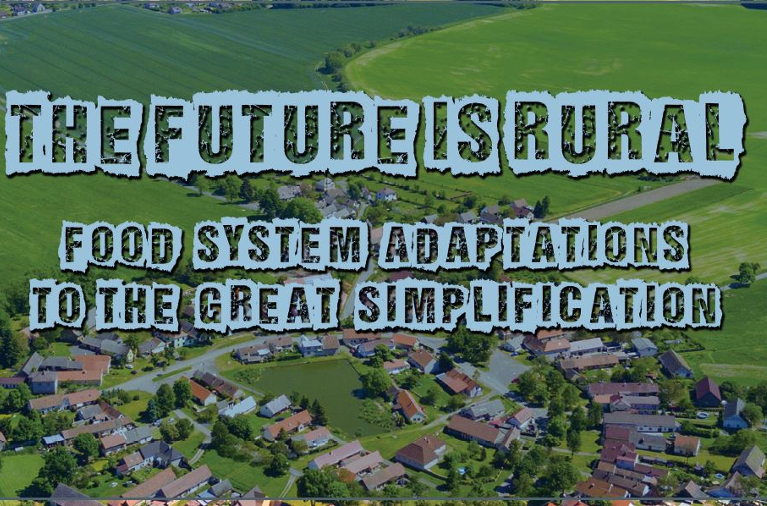 This article is based on a new report by Post Carbon Board President Dr. Jason Bradford, a biologist and farmer, offers a deeply researched perspective on the future of food and reveals key blind spots in conventional wisdom on energy, technology, and demographics. The Future Is Rural: Food System Adaptations to the Great Simplification presents Jason’s analysis from his career in ecology and agriculture, as well as a synthesis of the historical and scientific underpinnings of the astonishing changes that will transform the food system and society as a whole. You can download the report here.
This article is based on a new report by Post Carbon Board President Dr. Jason Bradford, a biologist and farmer, offers a deeply researched perspective on the future of food and reveals key blind spots in conventional wisdom on energy, technology, and demographics. The Future Is Rural: Food System Adaptations to the Great Simplification presents Jason’s analysis from his career in ecology and agriculture, as well as a synthesis of the historical and scientific underpinnings of the astonishing changes that will transform the food system and society as a whole. You can download the report here.
A common way to forecast the future is to study trends. All else being equal, it makes sense that what was true in the recent past is likely to hold for the near future. And so it goes for predictions of global society in the 21st century, where experts believe the world will become wealthier and more urban (Figure 1).
Figure 1. Percent of Global Population in Rural vs Urban Settings from 1950 to Present, with United Nations Projections to 2050.[i]

I happen to think much of this is wrong, as most trend analyses lack a proper causal model. For example, you could extrapolate from the first second a baseball leaves the bat of a slugger and project a path into outer space, but without incorporating the force of gravity you’d be clearly wrong a few seconds later. Likewise, there are simple forces—energy realities in this case—that are missing from standard analyses, and these forces will bend upward trajectories in economics and demographics back towards Earth.
Whether because we can no longer afford the damage caused by burning fossil hydrocarbons or because they are a nonrenewable resource, the era of oil, coal, and natural gas will come to an end in the foreseeable future. Mass urbanization has been made possible by the prodigious exploitation of fossil fuels. Cities have always been wholly reliant on the capacity of rural areas to produce basic goods, most importantly food. But due to the concentrated energy in oil, with its ability to power heavy equipment and transport goods over long distances, cities have been able to reach the scale they do today by drawing support from a land base often several hundred times their own area.[ii]
As oil gushers slow to a trickle, renewable energy sources and technologies will not be able to compensate fully for the decline of fossil fuels.[iii] Replacements for petroleum products, both existing and theoretical, are significantly more difficult and expensive to use, or come with unwanted tradeoffs (Figure 2). Society will have to get by on less energy and will have to use energy very differently, and these changes will have profound ripple effects on the economy, politics, and culture. [iv]
Figure 2. Energy density (gross heating value) of various storage forms is plotted by weight (MJ/kg) and volume (MJ/l).

An ideal energy storage source has both high gravimetric and volumetric density (upper right corner of graph). Alternatives to fossil fuels tend to be of lower density, making them more burdensome and costlier to use in general. Work performed will be less than gross heating value due to conversion inefficiencies, and efficiency can vary by the kind of work and how well the storage system is suited to it. For example, electric batteries to electric motors is a more efficient conversion (about 90%) than gasoline to internal combustion engines (about 30%). Batteries and other potential storage technologies can improve, but even at theoretical limits they would be many times less energy-dense than fossil fuels.
In anthropological terms, as we have less energy available, our society will become less complex, characterized by fewer monetary transactions and an increase in subsistence and informal economies. Progressively less energy from fossil fuels will require greater labor inputs and less reliance on mechanization over time. As energy use in countries like the U.S. declines over the coming decades, rural areas will repopulate, and lifestyles may resemble those in countries that never had access to vast energy supplies (Figure 3). [vi]
Figure 3. Per capita energy consumption and rural population by country (2008).

The percentage of population that is rural is plotted with respect to per capita energy consumption and shows that in general, countries with high energy use tend to be more urbanized. Some of the largest countries are highlighted, and outliers tend to be small island nations.[vii]
Food, its scarcity, the desire and opportunity to grow it, and the need to do it in ways that are appropriate to place and circumstance, will drive demographic shifts this century. People with life experiences and training suited for the urban environment are going to need a rapid education on what it takes to live off the land, and so-called conventional farmers and ranchers will have a steep learning curve to adopt more frugal and sustainable methods. But farmers and ranchers are not the only ones who need help adjusting to 21st century pressures. A society that actively supports them is also crucial to their success. If you are an educator, policy maker, someone who works in the food sector, or you have expertise in finance, energy, or transportation services, The Future is Rural report can help you think about how to nudge people toward a more thrifty and rural life, build and protect soils, and feed population centers that are living on less energy.
Good food is more than a means of subsistence; it is ultimately a deep cultural trait. The enormous energy contained in fossil hydrocarbons was an amazing gift, but it came with a hefty price, including real losses of regional self-reliance. Some worry that in losing access to cheap energy the worst aspects of the past, such as xenophobic tribalism, will resurface. Navigating energy descent will likely require that we take the best of liberal world views—like openness to ideas, enthusiasm for change, and tolerance of differences—and at the same time be deeply conservative—valuing interpersonal relationships, demanding respect and civility when those are under threat, and rediscovering a land ethic that resets social norms to help us restore and protect the places we love. We can rebuild the food system in ways that reflect energy, soil, and climate realities, seeking opportunities to recover elements of past cultures that inhabited the Earth with grace. Something new will arise, and in the evolution of what comes next, many may find what is often lacking in life today—the excitement of a profound challenge, meaning beyond the self, a deep sense of purpose, and commitment to place.
[i] United Nations Population Division, World Urbanization Prospects 2018: https://esa.un.org/unpd/wup/.
[ii] Folke, Carl, Asa Jansson, Jonas Larsson and Robert Costanza, “Ecosystem Appropriate by Cities,” (Ambio 26(3): 1997), 167-172.
[iii] Heinberg, Richard, and David Fridley. Our Renewable Future: Laying the Path for 100% Clean Energy. (Washington: Island Press, 2016), http://ourrenewablefuture.org/.
[iv] The intimate relationship between energy and culture is often called White’s Law: https://en.wikipedia.org/wiki/White%27s_law. To explore what future societies may be like, an excellent resource is: Fleming, David and Shaun Chamberlin, Surviving the Future: Culture, Carnival, and Capital in the Aftermath of the Market Economy, (Chelsea Green Publishing, 2016).
[v] For a discussion of energy density and limits to technical advances see: Zenz House, Kurt, “The limits of energy storage technology,” (Bulletin of the Atomic Scientists, January 20, 2009), https://thebulletin.org/2009/01/the-limits-of-energy-storage-technology. Data for chart from: https://www.engineeringtoolbox.com/fossil-fuels-energy-content-d_1298.html, https://en.wikipedia.org/wiki/Energy_density, and https://en.wikipedia.org/wiki/Energy_content_of_biofuel.
[vi] Holmgren, David, Feeding Retrosuburbia: from the Backyard to the Bioregion, (Holmgren Design, 2018).
[vii] Original data from U.S. Energy Information Agency on energy and United Nations DESA/Population Division World Urbanization Prospects on population. Data sets harmonized by author.





